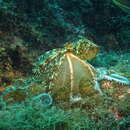pt-BR
nomes no trilho de navegação


Octopus salutii or the spider octopus is a species of cephalopods in the family Octopodidae. It ranges from 4.0 to 13.0 cm ML in males and 3.5 to 16.5 cm ML in females.[2] Octopus salutii are found at depths ranging from 100 to 700m however, they are most abundant at depths of 250 to 500m.[2]
Octopus salutii are marine benthic organisms that can be found in the Mediterranean Sea and Northeast Atlantic, from southern Spain to Morocco. Western Mediterranean sea salutii inhabit the lower continental self and the upper slope.[2] Found between the depths of 250 to 500m. Western Mediterranean Sea juveniles inhabit inaccessible areas to avoid trawlers and use the shelfs as reproductive grounds.[2] This species has little to no interest to the market because of its poor consistency of the mantle.
Predators - Grampus griseus, in the family Delphinidae.[4]
Prey - Western Mediterranean Sea species stomach content included 33 different prey belonging to 3 major taxonomic groups. 87% being crustaceans, 25% being fish and 10% being cephalopods.[2]
Male O. salutii have a well-developed ligulae which is used to transfer sperm to the female. O. salutii lay 2,000-4,000 eggs at a time which are 5.2 to 6.0 mm long.[5] Offspring's are planktonic for the first stage of their life. Four life cycles; egg, larva, juvenile and then adult. Males and females will die shortly after . Male usually die a few months after mating and female adults usually die shortly after hatching the eggs.[6]
The Biology of Octopus salutii is poorly known. This is because the species has no value to the market and is difficult to catch for research purposes. To identify the maturity of the species there are 3 stages to clear; immature (ovaries are white, small), maturing (ovaries are yellowish with granular structures), and mature (ovaries full of eggs).
Octopus salutii or the spider octopus is a species of cephalopods in the family Octopodidae. It ranges from 4.0 to 13.0 cm ML in males and 3.5 to 16.5 cm ML in females. Octopus salutii are found at depths ranging from 100 to 700m however, they are most abundant at depths of 250 to 500m.
Le Poulpe de Saluzzi[2], Octopus salutii, est une espèce d'octopodes de la famille des Octopodidae.
Cette espèce est présente dans les eaux de la mer Méditerranée (au large du Maroc, de l'Espagne et de la Grèce) et dans l'Atlantique[3].
Le Poulpe de Saluzzi, Octopus salutii, est une espèce d'octopodes de la famille des Octopodidae.
O polbo de patas longas (Octopus salutii, Vérany 1836; antes Octopus saluzzii) é un molusco cefalópodo pertencente á orde Octopoda.
Caracterízase porque os tentáculos son considerablemente máis longos que no polbo común (Octopus vulgaris). Ademais, a expansión terminal do brazo copulador, ou hectocotilo, é destacada, longa e con numerosas bandas transversais.
Segundo Rosa Ramonell péscase con frecuencia nas costas galegas, especialmente ó sur de Fisterra, con artes de arrastre, a profundidades de 200 a 500 metros.
O polbo de patas longas (Octopus salutii, Vérany 1836; antes Octopus saluzzii) é un molusco cefalópodo pertencente á orde Octopoda.
Caracterízase porque os tentáculos son considerablemente máis longos que no polbo común (Octopus vulgaris). Ademais, a expansión terminal do brazo copulador, ou hectocotilo, é destacada, longa e con numerosas bandas transversais.
Segundo Rosa Ramonell péscase con frecuencia nas costas galegas, especialmente ó sur de Fisterra, con artes de arrastre, a profundidades de 200 a 500 metros.
Octopus salutii is een soort in de taxonomische indeling van de inktvissen, een klasse dieren die tot de stam der weekdieren (Mollusca) behoort. De inktvis komt enkel in zout water voor en is in staat om van kleur te veranderen. Hij beweegt zich voort door water in zijn mantel te pompen en het er via de sifon weer krachtig uit te persen. De inktvis is een carnivoor en zijn voedsel bestaat voornamelijk uit vis, krabben, kreeften en weekdieren die ze met de zuignappen op hun grijparmen vangen.
De inktvis komt uit het geslacht Octopus en behoort tot de familie Octopodidae. Octopus salutii werd in 1836 beschreven door Vérany.[1]
Bronnen, noten en/of referentiesOctopus salutii é uma espécie de molusco pertencente à família Octopodidae.
A autoridade científica da espécie é Vérany, tendo sido descrita no ano de 1836.
Trata-se de uma espécie presente no território português, incluindo a zona económica exclusiva.
Octopus salutii é uma espécie de molusco pertencente à família Octopodidae.
A autoridade científica da espécie é Vérany, tendo sido descrita no ano de 1836.
Trata-se de uma espécie presente no território português, incluindo a zona económica exclusiva.